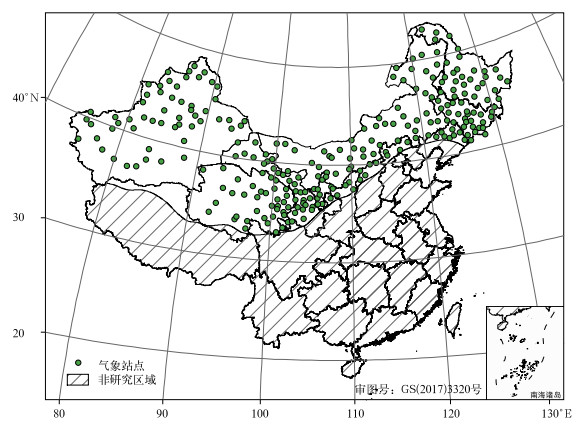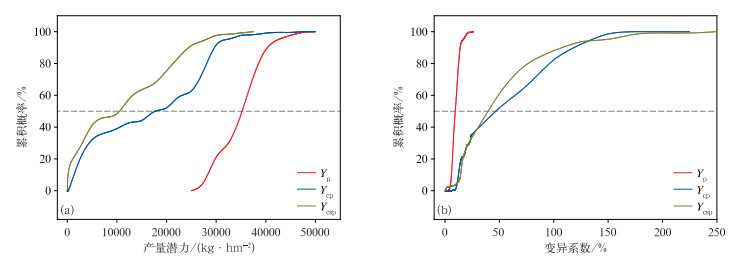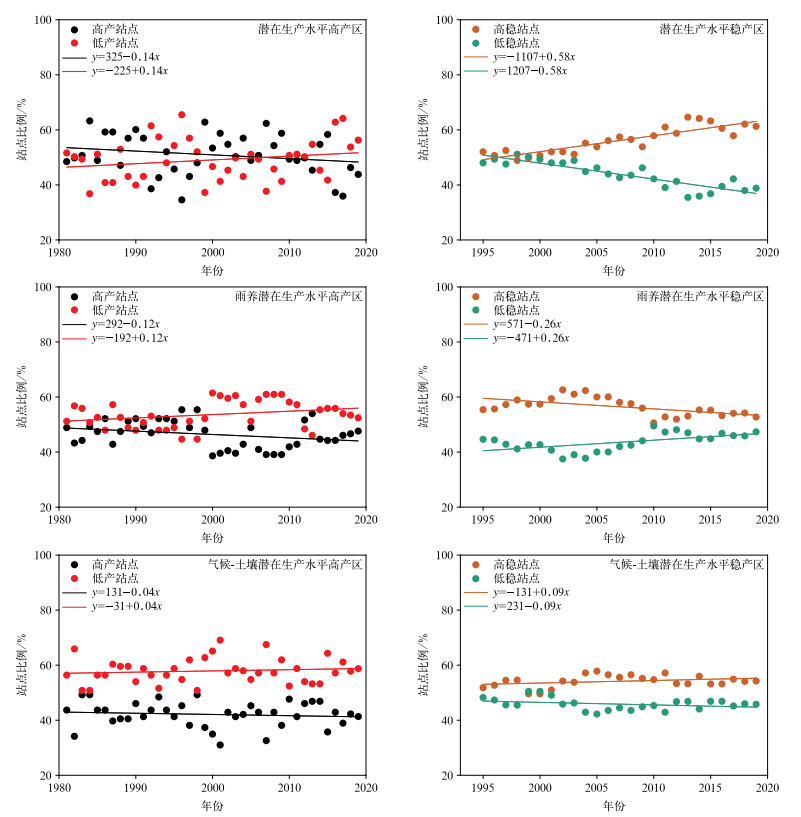Distributions of High and Stable Yield Zones for Potato in the Single-cropping Region in Northern China
-
摘要: 北方一作区马铃薯种植面积和总产量居我国首位,明确其高产稳产区分布,对马铃薯种植合理布局具有重要意义。基于1981—2019年研究区域内234个气象站点逐日气象数据以及作物、土壤数据,利用APSIM-Potato模型,以产量平均值和变异系数为高产性和稳产性评价指标,将研究区域划分为高产高稳、高产低稳、低产高稳和低产低稳4个亚区,分析不同生产水平下我国北方一作区马铃薯高产稳产区分布特征,探讨降水和土壤对马铃薯高产性和稳产性的影响。结果表明:不同生产水平下马铃薯高产区比例呈下降趋势;随着限制因素增加,高产高稳区面积比例逐渐降低,气候-土壤潜在生产水平下高产高稳区面积比例仅占研究区域总面积的13%;高产低稳区是潜在的高产高稳区,及时采取有效措施可提升稳产性。降水对马铃薯高产性和稳产性的影响大于土壤。实际生产中,降水和土壤限制下高产性和稳产性降低的区域,应注意结合当地灌溉条件配合耕作措施,以确保马铃薯高产稳产。
-
关键词:
- 北方一作区;
- 马铃薯;
- 高产稳产区;
- 产量潜力;
- APSIM-Potato模型
Abstract: The planting area and production of potato in the single-cropping region in northern China (SCRN) are in the first place in China, which plays a prominent role for maintaining national food security. It's essential to understand the potato yield potential in SCRN for regional optimized distribution and improvement of potato production. Two indices, i.e., the average and the coefficient of variation of potato yield potential under different production levels, are employed to investigate the potato yield level and yield stability. Based on the meteorological data from 234 weather stations from 1981 to 2019, the soil data and the crop data in the study region, the yield potentials under different production levels (i.e., potential production level, rainfed potential production level, and the climate-soil potential production level, respectively) are simulated using the well-calibrated and validated Agricultural Production Systems sIMulater of Potato (APSIM-Potato). The study area is classified into four types of zones with different yield patterns: High yield level and high yield stability zones, high yield level and low yield stability zones, low yield level and high yield stability zones, and low yield level and low yield stability zones. Based on the zoning indices and the standards, the distributions of four types of yield zones under different production levels are clarified and the effect of precipitation and soil on yield level and yield stability are analyzed. An increasing trend of the station percentage for high yield zones is defined during the period from 1981 to 2019. The proportion of high yield level and high yield stability zones in the study area decreases gradually with the constraints increasing from the potential production level with the radiation and temperature constrained to the climate-soil potential production level with the radiation, temperature, precipitation and soil constrained. Only 13% of the study area over the study period (1981-2019) shows the yield pattern of high yield level and high yield stability zones under the climate-soil potential production level. The high yield level and low yield stability zones are the potential high yield level and high yield stability zones in the future, which need further attention and effective measures to improve the yield stability of potato. Precipitation shows a greater effect on the potato yield level and yield stability than soil in the study region. To ensure the high and stable yield of potato in the study region, more attentions should be paid on the regions with negative effect of precipitation and soil on the yield level and yield stability. Actions should be taken into considering both on the local irrigation levels and the tillage measures. -
表 1 不同生产水平下马铃薯产量潜力意义及影响因素
Table 1 The definition of yield potentials and influencing factors under different production levels
生产水平 产量层次 影响因素 意义 潜在生产水平 光温产量潜力Yp 辐射、温度 作物产量的上限 雨养潜在生产水平 气候产量潜力Ycp 辐射、温度、降水 没有灌溉条件地区作物产量的上限 气候-土壤潜在生产水平 气候-土壤产量潜力Ycsp 辐射、温度、降水、土壤 当地气候资源和土壤因素决定的产量 表 2 不同生产水平下马铃薯产量潜力模拟情景设置
Table 2 Scenarios to simulate the yield potentials under different production levels in the APSIM-Potato
产量层次 品种 土壤 管理 灌溉 施肥 光温产量潜力Yp 克新一号 适宜 充分 充分 气候产量潜力Ycp 克新一号 适宜 雨养 充分 气候-土壤产量潜力Ycsp 克新一号 实际 雨养 充分 表 3 不同生产水平下马铃薯高产区和稳产区面积及比例
Table 3 Cropping areas and proportions of yield level zones and yield stability zones under different production levels
区域 潜在生产水平 雨养潜在生产水平 气候-土壤潜在生产水平 面积/(106 km2) 比例/% 面积/(106 km2) 比例/% 面积/(106 km2) 比例/% 高产区 3.31 66 1.70 34 1.53 31 低产区 1.69 34 3.30 66 3.47 69 高稳区 3.10 62 1.43 29 1.27 25 低稳区 1.90 38 3.57 71 3.73 75 表 4 不同生产水平下马铃薯高产稳产区面积及比例
Table 4 Cropping areas and proportions of high-stable zones for potato under different production levels in the study region
区域 潜在生产水平 雨养潜在生产水平 气候-土壤潜在生产水平 面积/(106 km2) 比例/% 面积/(106 km2) 比例/% 面积/(106 km2) 比例/% 高产高稳区 1.99 40 1.26 25 0.65 13 高产低稳区 1.21 24 0.42 8 0.71 14 低产高稳区 0.69 14 0.41 8 1.63 33 低产低稳区 1.11 22 2.91 59 2.01 40 -
[1] FAO. FAOSTAT. http://faostat3.fao.org/home/E.2020. [2] Wang N, Reidsma P, Pronk A, et al. Can potato add to China's food self-sufficiency?The scope for increasing potato production in China. European Journal of Agronomy, 2018, 101: 20-29. doi: 10.1016/j.eja.2018.07.002 [3] 李扬, 王靖, 唐建昭, 等. 中国马铃薯主产区生产特点、限制因子和对策分析. 中国马铃薯, 2020, 34(6): 374-382. doi: 10.3969/j.issn.1672-3635.2020.06.007Li Y, Wang J, Tang J Z, et al. Analysis of production characteristics, restrictive factors, and strategies for main potato production areas in China. Chinese Potato Journal, 2020, 34(6): 374-382. doi: 10.3969/j.issn.1672-3635.2020.06.007 [4] Tang J Z, Wang J, Fang Q X, et al. Optimizing planting date and supplemental irrigation for potato across the agro-pastoral ecotone in North China. European Journal of Agronomy, 2018, 98: 82-94. doi: 10.1016/j.eja.2018.05.008 [5] Jansky S H, Jin L P, Xie K Y, et al. Potato production and breeding in China. Potato Research, 2009, 52(1): 57-65. doi: 10.1007/s11540-008-9121-2 [6] 腾宗璠, 张畅, 王永智. 我国马铃薯适宜种植地区的分析. 中国农业科学, 1989, 22(2): 35-44. doi: 10.3321/j.issn:0578-1752.1989.02.005Teng Z F, Zhang C, Wang J Z. Study on China's potato cultivation divisions. Scientia Agricultura Sinica, 1989, 22(2): 35-44. doi: 10.3321/j.issn:0578-1752.1989.02.005 [7] 隋启君, 李先平, 杨万林. 中国马铃薯生产情况分析. 西南农业学报, 2008, 21(4): 1182-1188. doi: 10.3969/j.issn.1001-4829.2008.04.067Sui Q J, Li X P, Yang W L. Situation analysis of potatoes production in China. Southwest China Journal of Agricultural Sciences, 2008, 21(4): 1182-1188. doi: 10.3969/j.issn.1001-4829.2008.04.067 [8] Wang Y D, Liu X L, Ren G X, et al. Analysis of the spatiotemporal variability of droughts and the effects of drought on potato production in northern China. Agricultural and Forest Meteorology, 2019, 264: 334-342. doi: 10.1016/j.agrformet.2018.10.019 [9] 何勇, 董文杰, 严晓瑜. 基于MODIS的我国北方农牧交错带植被生长特征. 应用气象学报, 2008, 19(6): 716-721. doi: 10.3969/j.issn.1001-7313.2008.06.011He Y, Dong W J, Yan X Y. Characteristics of vegetation growth in the farming-pastoral zone over the North parts of China based on MODIS data. Journal of Applied Meteorological Science, 2008, 19(6): 716-721. doi: 10.3969/j.issn.1001-7313.2008.06.011 [10] 孙文堂, 苗春生, 沈建国, 等. 基于GIS的马铃薯种植气候区划及风险区划的研究. 南京气象学院学报, 2004, 27(5): 650-659. doi: 10.3969/j.issn.1674-7097.2004.05.009Sun W T, Miao C S, Shen J G, et al. Potato agricultural climate and harvest risk demarcation using GIS technique. Journal of Nanjing Institute of Meteorology, 2004, 27(5): 650-659. doi: 10.3969/j.issn.1674-7097.2004.05.009 [11] 王连喜, 朱贇贇, 李剑萍, 等. 宁夏马铃薯种植的气候分区和风险评估. 中国农业气象, 2011, 32(1): 100-105. doi: 10.3969/j.issn.1000-6362.2011.01.018Wang L X, Zhu Y Y, Li J P, et al. Climatic division and risk evaluation for potato planting in Ningxia. Chinese Journal of Agrometeorology, 2011, 32(1): 100-105. doi: 10.3969/j.issn.1000-6362.2011.01.018 [12] 徐玲玲, 毛留喜, 马雅丽. 基于细网格的山西省马铃薯种植气候区划. 干旱地区农业研究, 2018, 36(5): 251-256. https://www.cnki.com.cn/Article/CJFDTOTAL-GHDQ201805036.htmXu L L, Mao L X, Ma Y L. Climatic regionalization for potato planting in Shanxi Province based on fine gridding. Agricultural Research in the Arid Areas, 2018, 36(5): 251-256. https://www.cnki.com.cn/Article/CJFDTOTAL-GHDQ201805036.htm [13] 屈振江, 周广胜, 魏钦平. 苹果花期冻害气象指标和风险评估. 应用气象学报, 2016, 27(4): 385-395. doi: 10.11898/1001-7313.20160401Qu Z J, Zhou G S, Wei Q P. Meteorological disaster index and risk assessment of frost injury during apple florescence. Journal of Applied Meteorological Science, 2016, 27(4): 385-395. doi: 10.11898/1001-7313.20160401 [14] 张蕾, 霍治国, 黄大鹏, 等. 10-11月海南省瓜菜苗期湿涝风险评估与区划. 应用气象学报, 2015, 26(4): 432-441. doi: 10.11898/1001-7313.20150405Zhang L, Huo Z G, Huang D P, et al. Assessment and distribution of waterlogging damage risks for melons and vegetables in Hainan province from October to November. Journal of Applied Meteorological Science, 2015, 26(4): 432-441. doi: 10.11898/1001-7313.20150405 [15] Sun J S, Zhou G S, Sui X H. Climatic suitability of the distribution of the winter wheat cultivation zone in China. European Journal of Agronomy, 2012, 43: 77-86. doi: 10.1016/j.eja.2012.05.009 [16] 王永利, 侯琼, 苗百岭, 等. 内蒙古马铃薯干旱风险区划. 应用气象学报, 2017, 28(4): 504-512. doi: 10.11898/1001-7313.20170411Wang Y L, Hou X, Miao B L, et al. Drought risk regionalization of potatoes in Inner Mongolia. Journal of Applied Meteorological Science, 2017, 28(4): 504-512. doi: 10.11898/1001-7313.20170411 [17] 程晋昕, 段长春, 闫生杰. 基于MaxEnt模型的薄壳山核桃气候适宜性区划. 应用气象学报, 2020, 31(5): 631-640. doi: 10.11898/1001-7313.20200510Cheng J X, Duan C C, Yan S J. Climate suitability regionalization of Pecan based on MaxEnt model. Journal of Applied Meteorological Science, 2020, 31(5): 631-640. doi: 10.11898/1001-7313.20200510 [18] 何燕, 李政, 廖雪萍. 基于GIS的巴西陆稻IAPAR-9种植气候区划研究. 应用气象学报, 2007, 18(2): 219-224. doi: 10.3969/j.issn.1001-7313.2007.02.012He Y, Li Z, Liao X P. Climatic zoning of Brazilian upland rice (IAPAR-9) planting based upon GIS. Journal of Applied Meteorological Science, 2007, 18(2): 219-224. doi: 10.3969/j.issn.1001-7313.2007.02.012 [19] 李颖, 赵国强, 陈怀亮, 等. 基于冬小麦农业气候分区的WOFOST模型参数标定. 应用气象学报, 2021, 32(1): 38-51. doi: 10.11898/1001-7313.20210104Li Y, Zhao G Q, Chen H L, et al. WOFOST model parameter calibration based on agro-climatic division of winter wheat. Journal of Applied Meteorological Science, 2021, 32(1): 38-51. doi: 10.11898/1001-7313.20210104 [20] 于振文. 作物栽培学-北方本. 北京: 中国农业出版社, 2003: 11-14.Yu Z W. Crop Cultivation Science: North. Beijing: China Agriculture Press, 2003: 11-14. [21] Zhao J, Yang X G. Spatial patterns of yield-based cropping suitability and its driving factors in the three main maize-growing regions in China. International Journal of Biometeorology, 2019, 63: 1659-1668. doi: 10.1007/s00484-019-01783-1 [22] McCown R L, Hammer G L, Hargreaves J N G, et al. APSIM: A novel software system for model development, model testing and simulation in agricultural systems research. Agricultural Systems, 1996, 50: 255-271. doi: 10.1016/0308-521X(94)00055-V [23] Keating B A, Carberry P S, Hammer G L, et al. An overview of APSIM, a model designed for farming systems simulation. European Journal of Agronomy, 2003, 18: 267-288. doi: 10.1016/S1161-0301(02)00108-9 [24] 李扬, 王靖, 唐建昭, 等. 播期和品种变化对马铃薯产量的耦合效应. 中国生态农业学报, 2019, 27(2): 296-304. DOI: 10.13930/j.cnki.cjea.180707.Li Y, Wang J, Tang J Z, et al. Coupling impacts of planting date and cultivar on potato yield. Chinese Journal of Eco-Agriculture, 2019, 27(2): 296-304. DOI: 10.13930/j.cnki.cjea.180707. [25] 龚高法, 简慰民. 我国植物物候期的地理分布. 地理学报, 1983, 50(1): 33-40. doi: 10.3321/j.issn:0375-5444.1983.01.004Gong G F, Jian W M. On the geographical distribution of phenodate in China. Acta Geographica Sinica, 1983, 50(1): 33-40. doi: 10.3321/j.issn:0375-5444.1983.01.004 [26] 程雪, 孙爽, 张方亮, 等. 我国北方地区苹果干旱时空分布特征. 应用气象学报, 2020, 31(1): 63-73. doi: 10.11898/1001-7313.20200106Cheng X, Sun S, Zhang F L, et al. Spatial and temporal distributions of apple drought in Northern China. Journal of Applied Meteorological Science, 2020, 31(1): 63-73. doi: 10.11898/1001-7313.20200106 [27] Zhao J, Yang X G. Distribution of high-yield and high-yield stability zones for maize yield potential in the main growing regions in China. Agriculutral and Forest Meteorology, 2018, 248: 511-517. doi: 10.1016/j.agrformet.2017.10.016 [28] 刘健, 蒋建莹. 不同观测分辨率强台风云系的遥感特征. 应用气象学报, 2014, 25(1): 1-10. http://qikan.camscma.cn/article/id/20140101Liu J, Jiang J Y. Multi-scale data sensitivity study on cloud analysis of strong typhoon. Journal of Applied Meteorological Science, 2014, 25(1): 1-10. http://qikan.camscma.cn/article/id/20140101 [29] 施能. 气象科研与预报中的多元分析方法. 北京: 气象出版社, 1995: 174-176.Shi N. Multi-analysis in Meteorology Research and Prediction. Beijing: China Meteorological Press, 1995: 174-176. [30] Leng G Y. Recent changes in county-level corn yield variability in the United States from observations and crop models. Science of the Total Environment, 2017, 607/608: 683-690. doi: 10.1016/j.scitotenv.2017.07.017 [31] Tang J Z, Wang J, Wang E L, et al. Identifying key meteorological factors to yield variation of potato and the optimal planting date in the agro-pastoral ecotone in North China. Agricultural and Forest Meteorology, 2018(256/257): 283-291. http://smartsearch.nstl.gov.cn/paper_detail.html?id=b8f0ada2600d7778c7c76679d5bab0da [32] Wang F X, Feng S Y, Hou X Y, et al. Potato growth with and without plastic mulch in two typical regions of Northern China. Field Crops Research, 2009, 110: 123-129. doi: 10.1016/j.fcr.2008.07.014 [33] Hou X Y, Wang F X, Han J J, et al. Duration of plastic mulch for potato growth under drip irrigation in an arid region of Northwest China. Agricultural and Forest Meteorology, 2010, 150: 115-121. doi: 10.1016/j.agrformet.2009.09.007 [34] 侯贤清, 李荣. 免耕覆盖对宁南山区土壤物理性状及马铃薯产量的影响. 农业工程学报, 2015, 31(19): 112-119. https://www.cnki.com.cn/Article/CJFDTOTAL-NYGU201519016.htmHou X Q, Li R. Effects of mulching with no-tillage on soil physical properties and potato yield in mountain area of southern Ningxia. Transactions of the Chinese Society of Agricultural Engineering, 2015, 31(19): 112-119. https://www.cnki.com.cn/Article/CJFDTOTAL-NYGU201519016.htm [35] 孙爽, 杨晓光, 赵锦, 等. 全球气候变暖对中国种植制度的可能影响XI. 气候变化背景下中国冬小麦潜在光温适宜种植区变化特征. 中国农业科学, 2015, 48(10): 1926-1941. doi: 10.3864/j.issn.0578-1752.2015.10.006Sun S, Yang X G, Zhao J, et al. The possible effects of global warming on cropping systems in China XI. The variation of potential light-temperature suitable cultivation zone of winter wheat in China under climate change. Scientia Agricultura Sinica, 2015, 48(10): 1926-1941. doi: 10.3864/j.issn.0578-1752.2015.10.006 [36] 农业工程技术编辑部. 中国马铃薯优势区域布局规划(2008-2015年). 农业工程技术, 2009(11): 4-7. https://www.cnki.com.cn/Article/CJFDTOTAL-NYGN200911003.htmEditorial Department of Agricultural Engineering and Technology. The layout planning of dominant potato growing area in China from 2008 to 2015. Agricultural Engineering Technology, 2009(11): 4-7. https://www.cnki.com.cn/Article/CJFDTOTAL-NYGN200911003.htm -


 设为首页
设为首页 加入收藏
加入收藏



 下载:
下载:





